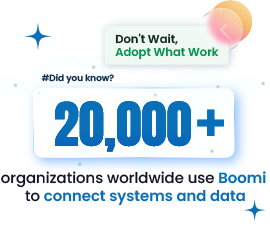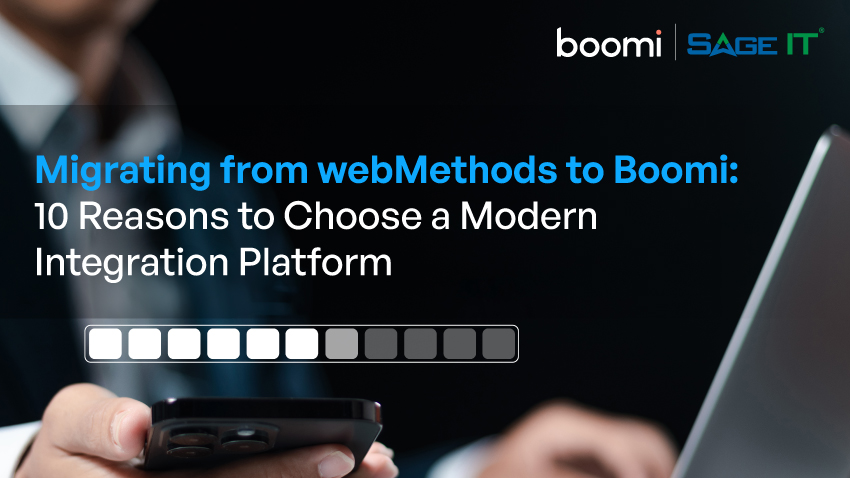“Struggling to keep your systems connected and make data-driven decisions in a fast-paced, tech-driven world? You’re not alone. Businesses across major industries—telecommunications, finance, manufacturing, and automotive—have turned to real-time data for growth. According to a recent study by the Centre for Economics and Business, 80% of businesses boosted revenue by leveraging real-time data, with a potential $2.6 trillion total revenue uplift across six countries.
This guide will show you how Boomi helps high-tech companies seamlessly integrate systems and harness AI (Artificial Intelligence) to make smarter, faster decisions. IT Managers, AI Specialists, and Executives will find actionable insights on using Boomi to transform their data management and decision-making processes.
Why is it necessary to have Boomi and AI for data-driven decisions, and what problems can they solve?
Disconnected Systems
Why is it necessary to have Boomi and AI for data-driven decisions, and what problems can they solve?
Inconsistent Data Flow Slows Down Critical Decisions
Inconsistent data leads to delays and confusion. Teams are forced to rely on outdated or mismatched information, which slows down key decisions.
Boomi addresses this using its data validation and cleansing features, ensuring that as data moves between systems, it’s accurate and up-to-date.
With AI-powered monitoring detecting issues in real-time, you avoid delays and make decisions based on reliable information.
Siloed Data
Siloed data creates barriers between departments, each using its own system and format. Marketing lacks the insights that sales has, and IT doesn’t see the full financial picture.
Boomi eliminates this by providing a unified data platform through Master Data Management (MDM). This consolidates data across departments into a single source of truth.
AI ensures that every update is reflected instantly, keeping everyone on the same page and avoiding confusion.
Operational Inefficiencies Caused by Fragmented Systems
When systems don’t align, everything from operations to decision-making slows down. Projects take longer, and teams face manual errors that lower productivity.
Boomi and AI overcome these inefficiencies by automating workflows across fragmented systems.
Boomi’s AI-driven integration lets processes run smoothly in the background, eliminating bottlenecks and allowing your team to focus on more strategic tasks.
Incomplete Data Leads to Costly Decision Failures
Disconnected systems and incomplete data lead to decisions based on inaccurate information, resulting in costly mistakes.
Boomi tackles this with real-time data synchronization, ensuring data is always up-to-date across systems.
AI monitors data flows and catches discrepancies early, so your leadership team can trust the numbers and make informed decisions without second-guessing the data’s accuracy.
Best Practices for Implementing Boomi and AI in High-Tech
1. Map Your Current Systems and Data Flow
The starting point for any successful integration is understanding your current landscape. Begin by identifying all the systems and data flows within your organization. With Boomi, this is more than just listing software — it’s about connecting the dots between where your data originates and where it’s needed most.
Pro Tip: Use tools like Visio to create a visual representation of your data flow. This helps you see inefficiencies and gaps in how data moves across your ecosystem.
2. Identify Key Integration Points
Data quality is critical for any integration effort. Boomi provides data validation tools that allow you to identify and cleanse incomplete or inconsistent data. This step ensures that you aren’t introducing errors into your integrated systems, helping maintain data integrity across your business.
Pro Tip: Set up data validation and cleansing processes using Boomi’s built-in features to standardize and prepare your data before initiating integration. This eliminates potential bottlenecks and reduces the chances of faulty integrations.
3. Prepare Data for Integration
Data quality is critical for any integration effort. Boomi provides data validation tools that allow you to identify and cleanse incomplete or inconsistent data. This step ensures that you aren’t introducing errors into your integrated systems, helping maintain data integrity across your business.
Pro Tip: Set up data validation and cleansing processes using Boomi’s built-in features to standardize and prepare your data before initiating integration. This eliminates potential bottlenecks and reduces the chances of faulty integrations.
4. Configure Boomi for Your Business Needs
Boomi’s low-code platform allows both IT professionals and non-technical teams to set up and test integrations easily. Once key systems are identified, create workflows to connect these systems using Boomi’s drag-and-drop interface.
Pro Tip: While Boomi doesn’t provide a specific sandbox environment, you should always use dedicated development and testing environments to validate workflows before moving to production. This ensures your configurations are functioning properly without affecting live operations.
5. Automate Repetitive Tasks for Maximum Productivity
Manual tasks like synchronizing data between systems can slow down operations and introduce human error. Boomi allows you to automate these workflows, streamlining data synchronization and validation processes to ensure consistency and accuracy across your systems.
Pro Tip: Use Boomi’s pre-built templates for common workflows to simplify the setup process. This can significantly reduce the time spent on configuration and testing.
6. Use Real-Time Monitoring for Seamless Performance
High-tech environments often experience rapid growth, and your integration setup must accommodate this. Boomi’s cloud-native architecture allows you to scale your integrations without the need for significant infrastructure changes. This means you can handle increased data loads or connect new systems as your business expands.
Pro Tip: Regularly review and test your workflows to ensure they are scalable. Running scalability tests with increased data loads can help you avoid bottlenecks as your business grows.
7. Prepare for Scalability
Integration doesn’t end with setup. It requires continuous monitoring to ensure smooth operation. Boomi offers real-time monitoring tools that allow you to track system performance and data flow. This helps you identify and resolve any issues early on, preventing downtime.
Pro Tip: Set up performance alerts within Boomi to be notified of any slowdowns or disruptions in data flow. This ensures you can respond quickly before small issues become larger problems.
8. Partner with a Boomi Consulting Expert for Long-Term Optimization
Configuring and optimizing Boomi workflows can be straightforward for small setups. For complex or large-scale integrations, engaging with a certified Boomi consulting partner can be highly beneficial. A partner brings specialized expertise to optimize workflows and ensure you’re getting the most out of your Boomi implementation.
A consulting partner can also help you integrate more advanced AI models into your system, ensuring your business remains at the forefront of AI-driven decision-making.

Practical Applications and Use Cases
SaaS Industry
In the SaaS industry, the VP of Engineering manages product teams using Jira for project management, GitHub for version control, and an ERP system for resource management. These systems don’t talk to each other, causing delays when trying to get updates on project status or allocate resources efficiently.
With Boomi integrated across Jira, GitHub, and the ERP system, the VP no longer has to manually pull updates or rely on multiple tools that don’t speak to each other. The data flow becomes seamless. Each time a developer commits code or an issue gets resolved in Jira, Boomi syncs the update with the ERP system in real-time. The VP now has full visibility into resources, development progress, and project timelines at a glance.
But it doesn’t stop at syncing data. AI automates repetitive tasks like tracking project milestones and sending alerts if something isn’t moving forward as expected. Instead of waiting for problems to escalate, the VP receives proactive notifications about where attention is needed.
Robotics Company
The Head of Marketing at a robotics company is responsible for overseeing campaigns across several platforms – HubSpot for CRM, Google Analytics for website performance, and Hootsuite for social media. It’s a digital-heavy role, but there’s a problem. The data from these platforms lives in silos. The team has a fragmented view of customer interactions, leading to marketing strategies that lack cohesion and personalization.
Boomi integrates HubSpot, Google Analytics, and Hootsuite into a single platform, bringing all customer data together in real time. Now, the marketing team has access to a complete view of how customers interact across channels. AI goes to work processing the data, helping the team segment audiences based on their behaviors and preferences. The marketing team can now deliver personalized campaigns that resonate with their audience.
The result? Campaigns that perform better, with higher engagement rates and a clear boost in ROI.
Cloud Infrastructure Company
At a cloud infrastructure company, the CFO oversees QuickBooks for finance, Workday for HR, and Asana for project management. These systems operate independently, creating data silos that slow down the process of generating financial reports and cause issues with payroll and resource allocation.
Boomi connects QuickBooks, Workday, and Asana into a unified platform, where data is shared in real time across finance, HR, and project management. Boomi automates data flow between these systems, ensuring that when a project is updated in Asana, it reflects in the finance and HR systems. AI manages the data reconciliation, ensuring payroll aligns with hours worked and that financial reports are generated accurately, without requiring manual intervention from the finance team.
How It Helps: With these systems integrated, the CFO has real-time visibility into project budgets, resource allocation, and payroll, significantly reducing the time spent gathering data.
Benefits of Boomi’s AI-Driven Integration for High-Tech Executives
Improved Decision-Making
AI-driven integration connects data from multiple systems, providing accurate, real-time insights. Automated data collection eliminates manual processes, offering a single, unified view of operations. This helps leaders rely on up-to-date information for critical decisions that affect performance, growth, and long-term business objectives.
Operational Efficiency
Manual workflows and redundant processes create bottlenecks, delays, and errors. Boomi automates these workflows, allowing faster data processing and reduced operational strain. Time-intensive tasks get minimized, and the focus can shift to strategic initiatives that directly impact business growth, reducing operational expenses and improving workflow consistency.
Scalability and Future-Readiness
Scaling complex systems without disrupting operations often becomes challenging. Boomi’s flexible architecture supports growth by integrating new systems and increasing data volumes without interruption. This capability provides long-term operational stability while meeting growing business demands, enabling smooth transitions during periods of expansion.
Strategic Alignment
Disparate systems often lead to inconsistent data and misaligned strategies across departments. Boomi creates a single source of truth by standardizing data, allowing cross-departmental collaboration and accurate reporting. This alignment enables organizations to execute strategic goals cohesively, eliminating confusion and delays caused by disjointed data streams.
Conclusion
Boomi and AI offer technical teams a method to manage system integrations and data-driven workflows with precision. Boomi connects systems and automates tasks, eliminating manual errors and offering real-time data insights to drive decisions. The platform’s low-code interface makes deployment accessible while maintaining control for experts.
For teams focusing on scalability, Boomi’s cloud-native infrastructure allows integrations to grow with business demands. Whether managing high-volume data or performance, Boomi AI provides reliable solutions tailored to technical needs. To explore how Boomi can elevate your integration strategy, connect with our Boomi-certified specialists for expert guidance.

















